Peugeot 3008 Hybrid 4 2014 Owner's Manual - RHD (UK. Australia)
Manufacturer: PEUGEOT, Model Year: 2014, Model line: 3008 Hybrid 4, Model: Peugeot 3008 Hybrid 4 2014Pages: 378, PDF Size: 22.55 MB
Page 101 of 378
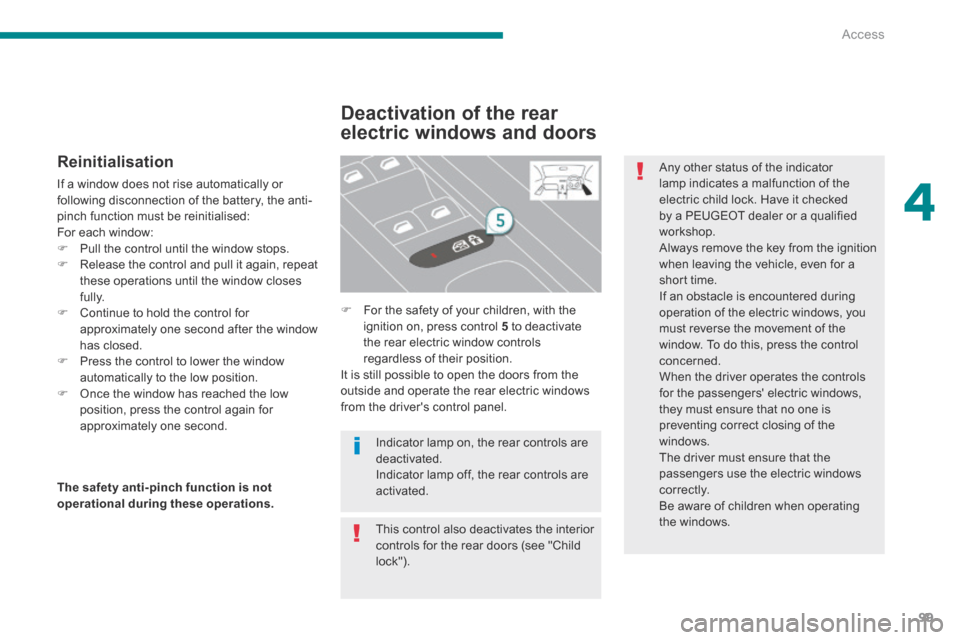
4
Access99
Reinitialisation
If a window does not rise automatically or following disconnection of the battery, the anti-pinch function must be reinitialised:
For each window: Pull the control until the window stops. Release the control and pull it again, repeat these operations until the window closes fully. Continue to hold the control for approximately one second after the window has closed. Press the control to lower the window automatically to the low position. Once the window has reached the low position, press the control again for approximately one second.
Deactivation of the rear
electric windows and doors
For the safety of your children, with the ignition on, press control 5 to deactivate the rear electric window controls regardless of their position. It is still possible to open the doors from the outside and operate the rear electric windows from the driver's control panel.
The safety anti-pinch function is not operational during these operations.
This control also deactivates the interior controls for the rear doors (see "Child lock").
Indicator lamp on, the rear controls are deactivated. Indicator lamp off, the rear controls are activated.
Any other status of the indicator lamp indicates a malfunction of the electric child lock. Have it checked by a PEUGEOT dealer or a qualified workshop. Always remove the key from the ignition when leaving the vehicle, even for a short time. If an obstacle is encountered during operation of the electric windows, you must reverse the movement of the window. To do this, press the control concerned. When the driver operates the controls for the passengers' electric windows, they must ensure that no one is preventing correct closing of the windows. The driver must ensure that the passengers use the electric windows c o r r e c t l y. Be aware of children when operating the windows.
Page 102 of 378
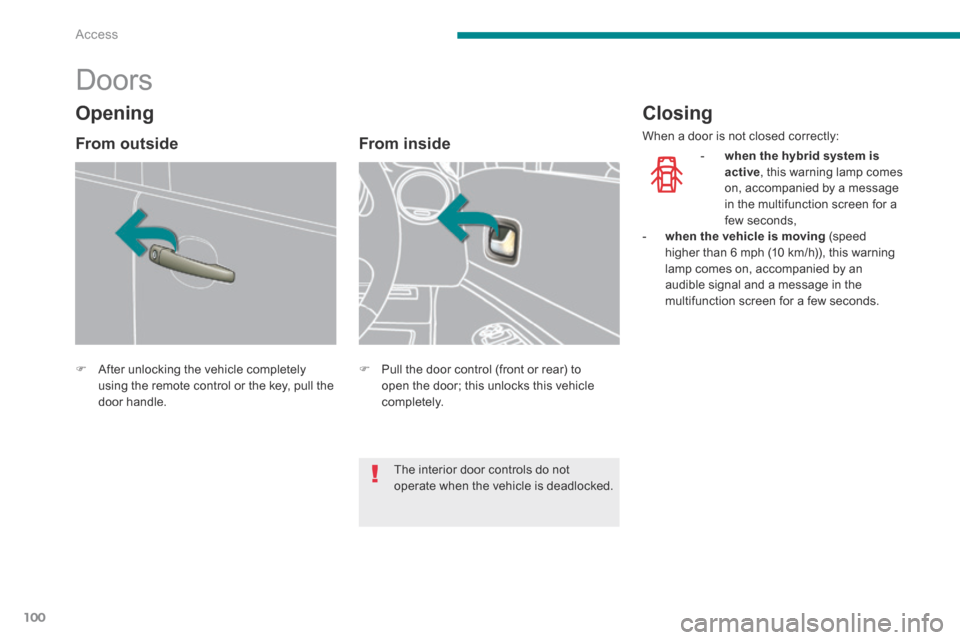
Access
100
Doors
After unlocking the vehicle completely using the remote control or the key, pull the door handle.
From inside
Pull the door control (front or rear) to open the door; this unlocks this vehicle completely.
Closing
When a door is not closed correctly:
- when the hybrid system is active , this warning lamp comes on, accompanied by a message in the multifunction screen for a few seconds, - when the vehicle is moving (speed higher than 6 mph (10 km/h)), this warning lamp comes on, accompanied by an audible signal and a message in the multifunction screen for a few seconds.
Opening
From outside
The interior door controls do not operate when the vehicle is deadlocked.
Page 103 of 378
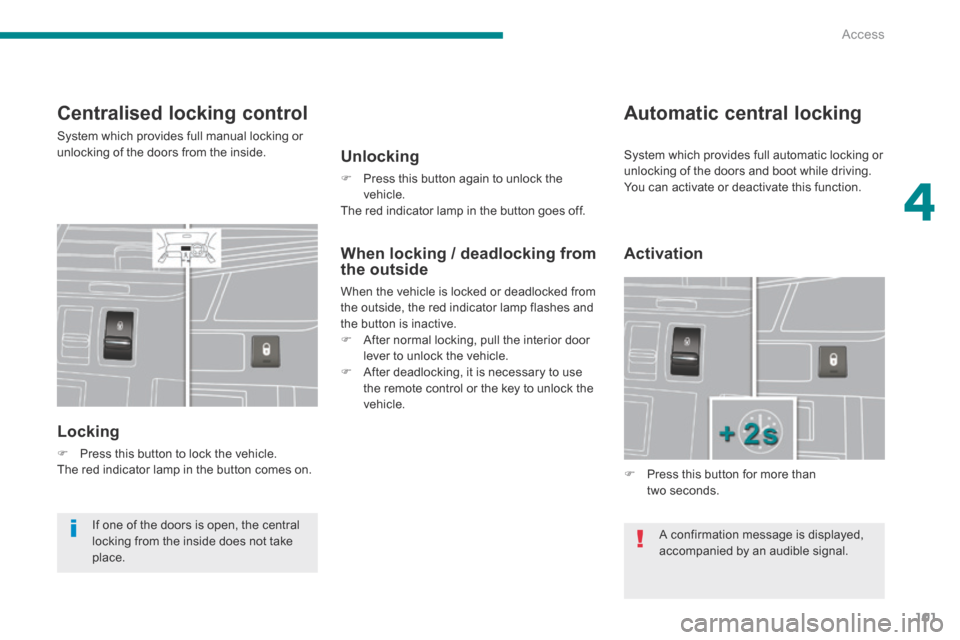
4
Access101
Centralised locking control
System which provides full manual locking or unlocking of the doors from the inside.
Locking
Press this button to lock the vehicle. The red indicator lamp in the button comes on.
Automatic central locking
Unlocking
Press this button again to unlock the vehicle. The red indicator lamp in the button goes off.
Activation
Press this button for more than two seconds.
A confirmation message is displayed, accompanied by an audible signal.
When locking / deadlocking from the outside
When the vehicle is locked or deadlocked from the outside, the red indicator lamp flashes and the button is inactive. After normal locking, pull the interior door lever to unlock the vehicle. After deadlocking, it is necessary to use the remote control or the key to unlock the vehicle.
If one of the doors is open, the central
locking from the inside does not take place.
System which provides full automatic locking or unlocking of the doors and boot while driving. You can activate or deactivate this function.
Page 104 of 378
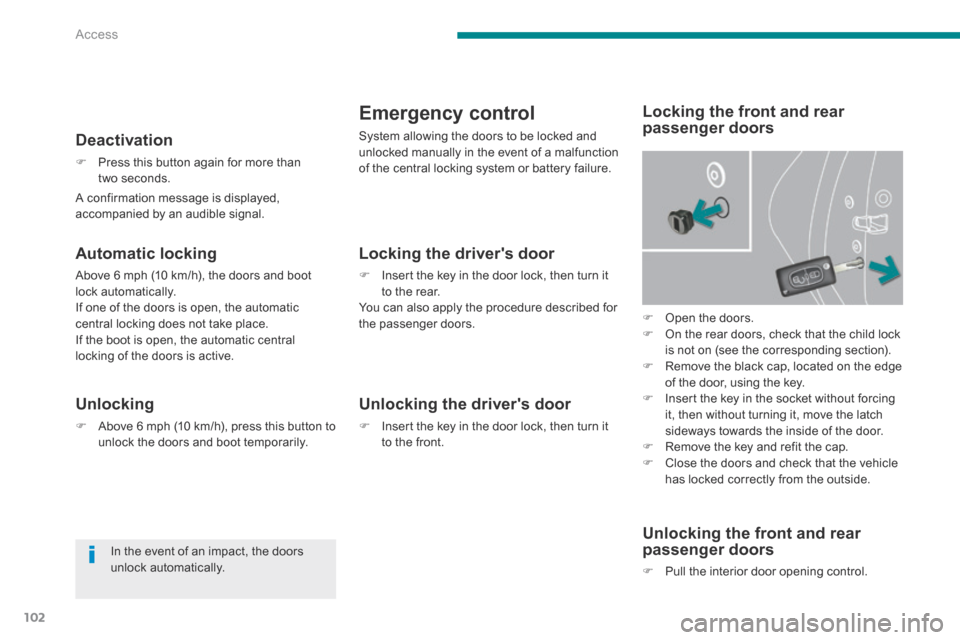
Access
102
A confirmation message is displayed, accompanied by an audible signal.
Deactivation
Press this button again for more than two seconds.
Unlocking
Above 6 mph (10 km/h), press this button to unlock the doors and boot temporarily.
Emergency control
System allowing the doors to be locked and unlocked manually in the event of a malfunction of the central locking system or battery failure.
Open the doors. On the rear doors, check that the child lock is not on (see the corresponding section). Remove the black cap, located on the edge of the door, using the key. Insert the key in the socket without forcing it, then without turning it, move the latch sideways towards the inside of the door. Remove the key and refit the cap. Close the doors and check that the vehicle has locked correctly from the outside.
Locking the driver's door
Insert the key in the door lock, then turn it to the rear. You can also apply the procedure described for the passenger doors.
Unlocking the driver's door
Insert the key in the door lock, then turn it to the front.
Locking the front and rear passenger doors
Unlocking the front and rear passenger doors
Pull the interior door opening control.
In the event of an impact, the doors unlock automatically.
Automatic locking
Above 6 mph (10 km/h), the doors and boot lock automatically. If one of the doors is open, the automatic central locking does not take place. If the boot is open, the automatic central locking of the doors is active.
Page 105 of 378
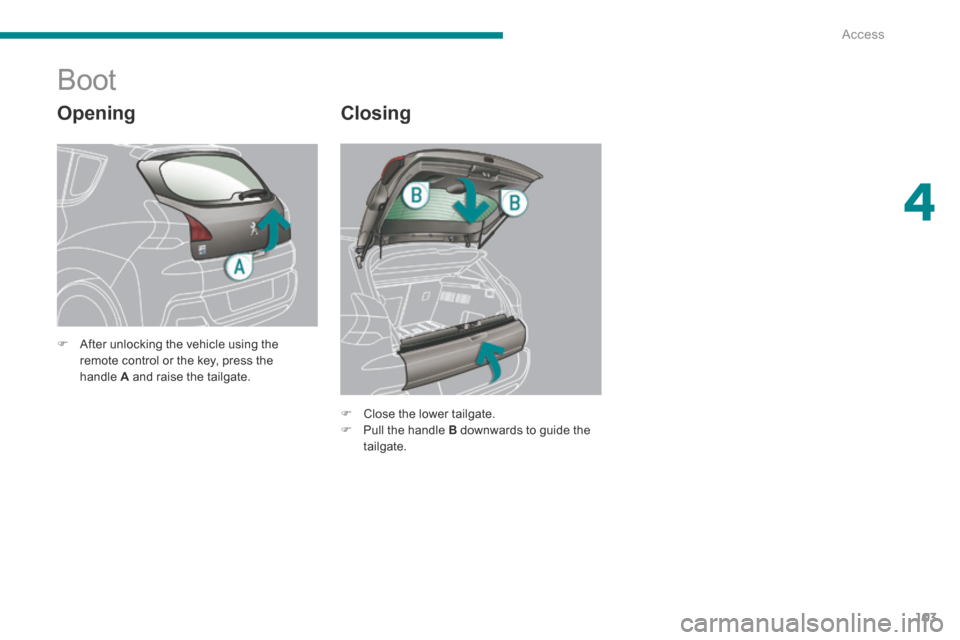
4
Access103
Opening
Boot
Closing
Close the lower tailgate. Pull the handle B downwards to guide the tailgate.
After unlocking the vehicle using the remote control or the key, press the handle A and raise the tailgate.
Page 106 of 378
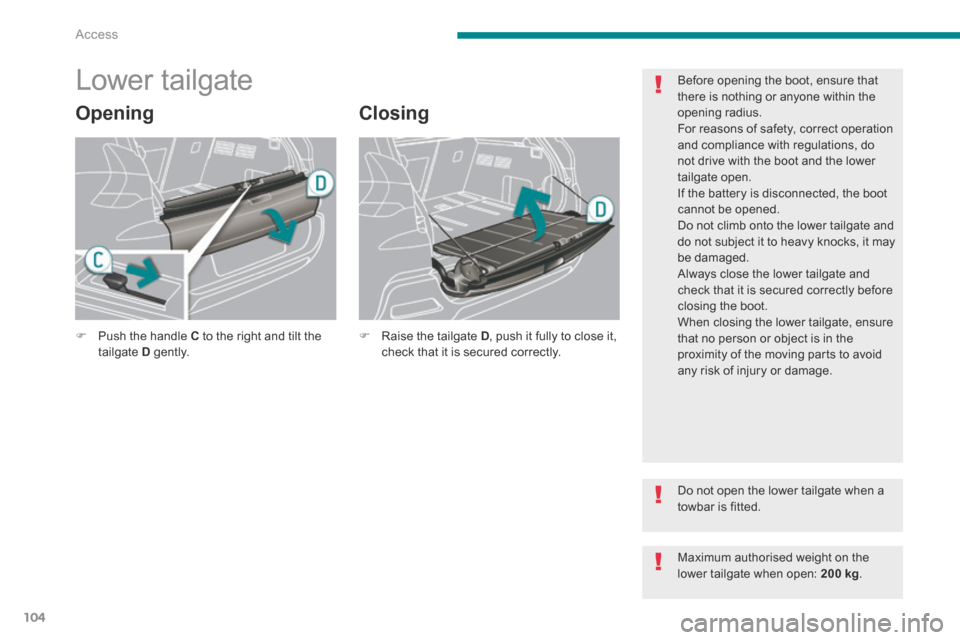
Access
104
Lower tailgate
Opening Closing
Push the handle C to the right and tilt the tailgate D g e nt l y. Raise the tailgate D , push it fully to close it, check that it is secured correctly.
Before opening the boot, ensure that there is nothing or anyone within the opening radius. For reasons of safety, correct operation and compliance with regulations, do not drive with the boot and the lower tailgate open. If the battery is disconnected, the boot cannot be opened. Do not climb onto the lower tailgate and do not subject it to heavy knocks, it may be damaged. Always close the lower tailgate and check that it is secured correctly before closing the boot. When closing the lower tailgate, ensure that no person or object is in the proximity of the moving parts to avoid any risk of injury or damage.
Do not open the lower tailgate when a towbar is fitted.
Maximum authorised weight on the lower tailgate when open: 200 kg .
Page 107 of 378
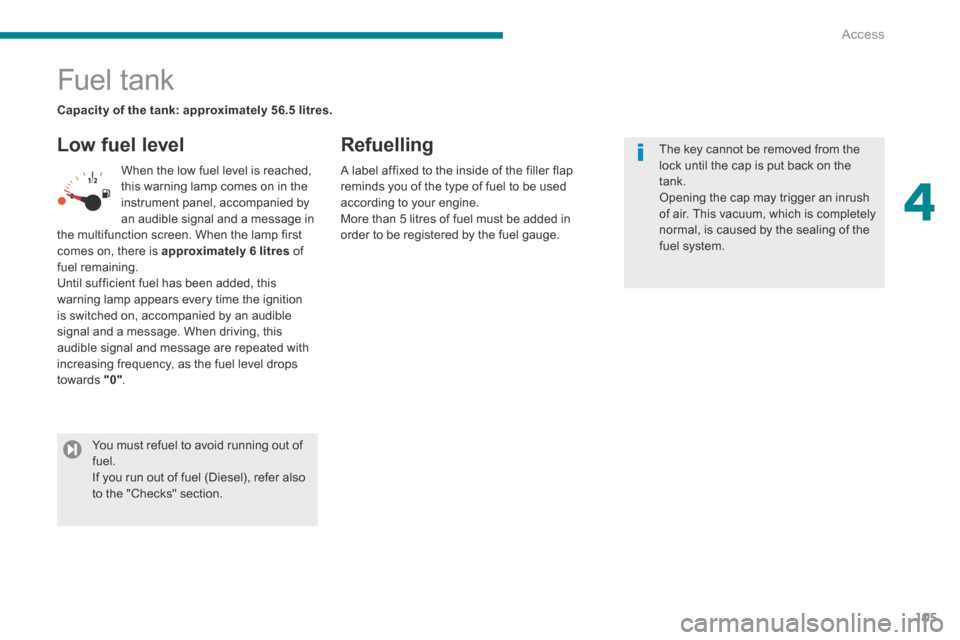
4
Access105
Fuel tank
Low fuel level Refuelling
When the low fuel level is reached, this warning lamp comes on in the instrument panel, accompanied by an audible signal and a message in
the multifunction screen. When the lamp first comes on, there is approximately 6 litres of fuel remaining. Until sufficient fuel has been added, this warning lamp appears every time the ignition is switched on, accompanied by an audible signal and a message. When driving, this audible signal and message are repeated with increasing frequency, as the fuel level drops towards "0" .
Capacity of the tank: approximately 56.5 litres.
A label affixed to the inside of the filler flap reminds you of the type of fuel to be used according to your engine. More than 5 litres of fuel must be added in order to be registered by the fuel gauge.
You must refuel to avoid running out of fuel. If you run out of fuel (Diesel), refer also to the "Checks" section.
The key cannot be removed from the lock until the cap is put back on the tank. Opening the cap may trigger an inrush of air. This vacuum, which is completely
normal, is caused by the sealing of the fuel system.
Page 108 of 378
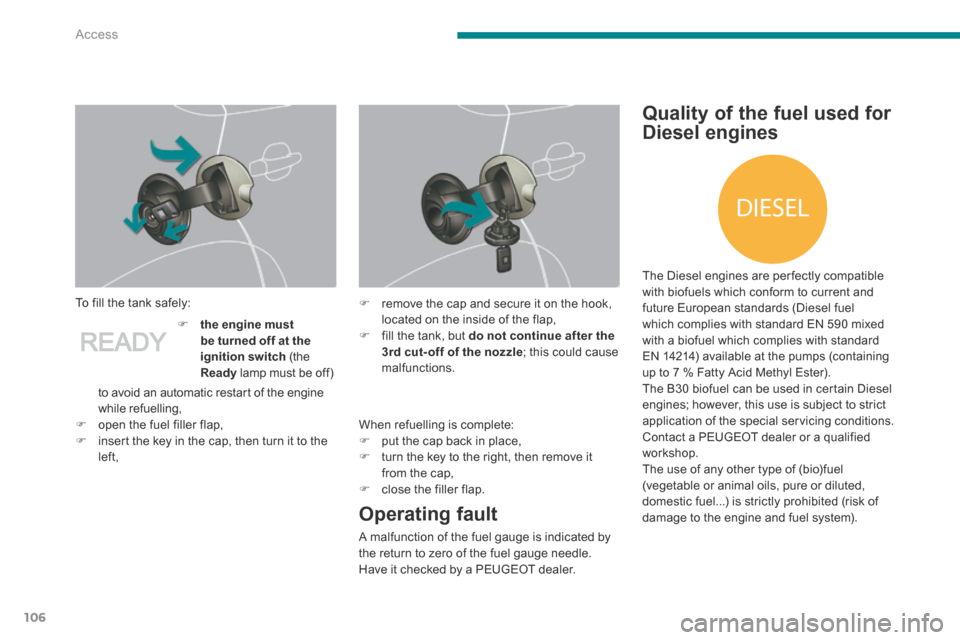
DIESEL
Access
106
To fill the tank safely:
When refuelling is complete: put the cap back in place, turn the key to the right, then remove it from the cap, close the filler flap.
Operating fault
A malfunction of the fuel gauge is indicated by the return to zero of the fuel gauge needle. Have it checked by a PEUGEOT dealer.
to avoid an automatic restart of the engine while refuelling, open the fuel filler flap, insert the key in the cap, then turn it to the left,
the engine must be turned off at the ignition switch (the Ready lamp must be off)
Quality of the fuel used for
Diesel engines
The Diesel engines are per fectly compatible with biofuels which conform to current and future European standards (Diesel fuel which complies with standard EN 590 mixed with a biofuel which complies with standard EN 14214) available at the pumps (containing up to 7 % Fatty Acid Methyl Ester). The B30 biofuel can be used in certain Diesel engines; however, this use is subject to strict application of the special servicing conditions. Contact a PEUGEOT dealer or a qualified workshop. The use of any other type of (bio)fuel (vegetable or animal oils, pure or diluted, domestic fuel...) is strictly prohibited (risk of damage to the engine and fuel system).
remove the cap and secure it on the hook, located on the inside of the flap, fill the tank, but do not continue after the 3rd cut- off of the nozzle ; this could cause malfunctions.
Page 109 of 378
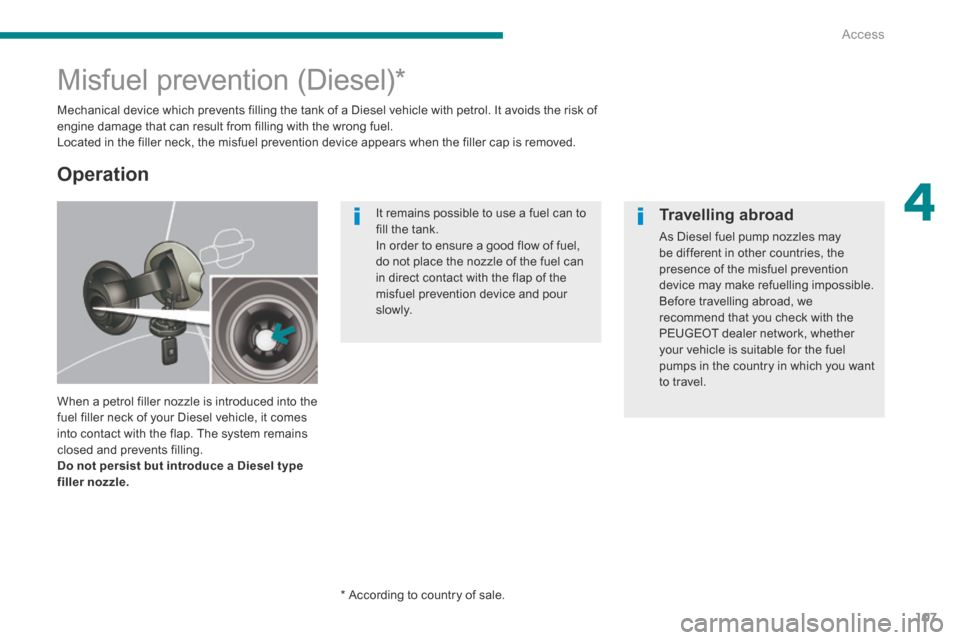
4
Access107
Misfuel prevention (Diesel) *
Mechanical device which prevents filling the tank of a Diesel vehicle with petrol. It avoids the risk of engine damage that can result from filling with the wrong fuel. Located in the filler neck, the misfuel prevention device appears when the filler cap is removed.
Operation
* According to country of sale.
It remains possible to use a fuel can to
fill the tank. In order to ensure a good flow of fuel, do not place the nozzle of the fuel can in direct contact with the flap of the misfuel prevention device and pour s l ow l y.
When a petrol filler nozzle is introduced into the fuel filler neck of your Diesel vehicle, it comes
into contact with the flap. The system remains closed and prevents filling. Do not persist but introduce a Diesel type filler nozzle.
Travelling abroad
As Diesel fuel pump nozzles may be different in other countries, the presence of the misfuel prevention device may make refuelling impossible. Before travelling abroad, we recommend that you check with the PEUGEOT dealer network, whether your vehicle is suitable for the fuel pumps in the country in which you want to travel.
Page 110 of 378
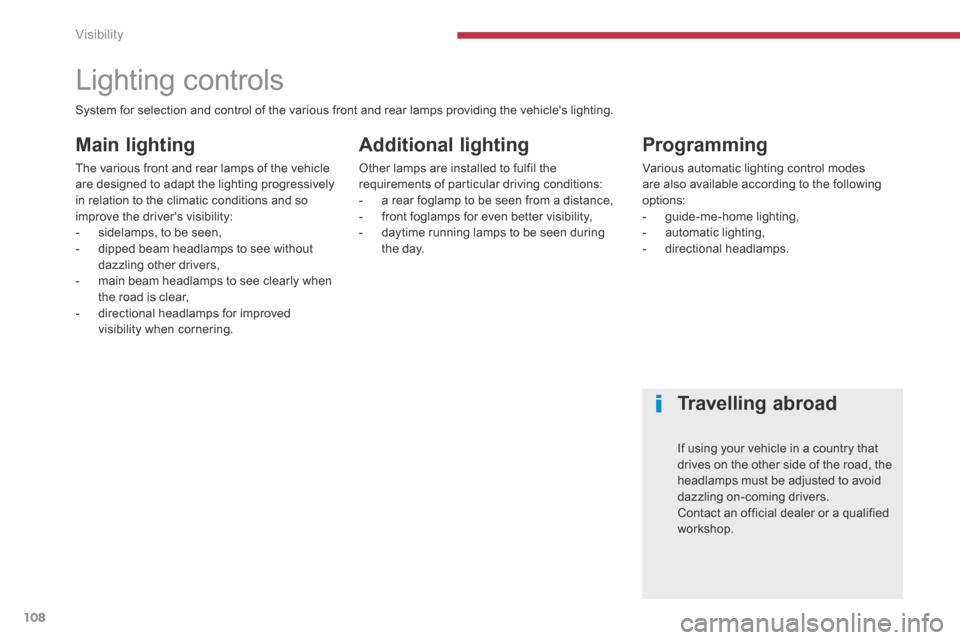
Visibility
108
Lighting controls
Main lighting
The various front and rear lamps of the vehicle are designed to adapt the lighting progressively in relation to the climatic conditions and so improve the driver's visibility: - sidelamps, to be seen, - dipped beam headlamps to see without dazzling other drivers, - main beam headlamps to see clearly when the road is clear, - directional headlamps for improved visibility when cornering.
Additional lighting
Other lamps are installed to fulfil the requirements of particular driving conditions: - a rear foglamp to be seen from a distance, - front foglamps for even better visibi lity, - daytime running lamps to be seen during the day.
Programming
Various automatic lighting control modes are also available according to the following options: - guide-me-home lighting, - automatic lighting, - directional headlamps.
System for selection and control of the various front and rear lamps providing the vehicle's lighting.
Travelling abroad
If using your vehicle in a country that drives on the other side of the road, the headlamps must be adjusted to avoid dazzling on-coming drivers. Contact an official dealer or a qualified workshop.